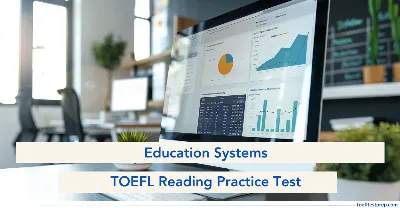Education Systems - TOEFL iBT® Reading Practice Test

"Improve your TOEFL Reading comprehension with practice passages on 'Education Systems,' exploring global education models and their impact."
Key Highlights
Education systems worldwide reflect diverse approaches to teaching, learning, and societal development. The TOEFL Reading section often features such topics, requiring you to identify key ideas, evaluate arguments, and understand global perspectives.
Practising passages on 'Education Systems' helps you build skills in analysing different educational frameworks, understanding their implications, and answering questions effectively—essential for success in the TOEFL Reading section.
Reading Instructions:
- You have 15 minutes to read the following passage and answer all 9 questions related to it.
- Most questions are worth 1 point, but the last question is worth more. The directions indicate how many points you will receive for that specific question.
- The specific section/paragraphs have been provided again with the question for ease of understanding and quick solution.
- Some questions include a word or phrase that is highlighted in the question as well as in the paragraph for quick reference.
Education Systems: A Comparative Analysis
Education systems around the world show a notable variety, shaped by cultural,economic, and historical contexts. The structure and belief of education can vary greatly from one country to another, influencing not only the course but also the teaching methods used in classrooms. For instance, while some nations focus on standardized testing as a measure of student success, others emphasize whole education that supports creativity and critical thinking. This passage aims to explore various education systems, highlighting their unique features, the reasons behind them, and the effects on students and society as a whole.
In many Western countries, such as the United States and the United Kingdom, education systems are defined by a tiered structure made up of primary, secondary, and tertiary levels. The focus is often on a broad course during the early years, allowing students to explore various subjects before specializing in specific areas of interest later on. This approach aims to provide a well-rounded education, providing students with a diverse skill set. Critics argue that the focus on standardized testing can lead to a narrow definition of success, where students feel pressured to perform well on exams instead of engaging deeply with the material. So, there are increasing calls for educational reform that prioritizes critical thinking and creativity over rote memorization.
In contrast, several Asian countries, including Japan and South Korea, have education systems that are often described as strict and competitive. These systems typically emphasize school success, with students frequently attending extra schools, known as juku in Japan or "hagwon" in South Korea, to enhance their learning. The high-pressure nature of exams in these countries can create an environment of intense pressure, raising concerns about student health and mental well-being. However, supporters of this model
argue that it encourages a strong work ethic and discipline, preparing students for the demands of a global economy. The success of students in international tests often reinforces the idea that such strict systems yield positive results.
At the same time, alternative education systems, like those in Finland, have gained international attention for their new approaches. The Finnish education system focuses on fairness and accessibility, with minimal standardized testing and a strong emphasis on teacher independence. Teachers in Finland are highly trained professionals who are trusted to design their own courses and tests, encouraging an environment of creativity and critical involvement. This model has led to high levels of student satisfaction and achievement, as shown by Finlands consistently strong performance in international tests like PISA (Programme for International Student Assessment). However, the success of this system raises questions about its suitability in other contexts, especially in countries with different cultural and economic conditions, where educational resources may be limited.
The role of technology in education is another important factor affecting modern education systems. With the rise of digital learning tools and online platforms, traditional classroom settings are changing. Many education systems are now adding technology into their courses, enabling customized learning experiences that cater to individual student needs. For example, blended learning combines face-to-face instruction with online resources, allowing students to learn at their own pace. However, this shift also brings challenges, such as ensuring equal access to technology and addressing the disparities that exist in many areas. So, policymakers must consider how to implement technology in a way that enhances learning without making existing disparities worse.
In conclusion, the variety of education systems worldwide reflects a complicated mix of cultural values, economic conditions, and historical developments. While each system has its strengths and weaknesses, the ongoing discussion about educational reform continues to shape the future of learning. Exploring these varied approaches offers valuable insights into how education can evolve to meet the needs of future generations. As societies deal with the demands of a rapidly changing world, questions remain about the effectiveness of different educational models and their effects on social equity and student well-being. More research is needed to understand how best to integrate successful elements from various systems to create a more inclusive and effective global education structure.
Directions: Once you have read the passage, answer the following questions.
Paragraph 1
Education systems around the world show a notable variety, shaped by cultural, economic, and historical contexts. The structure and belief of education can vary greatly from one country to another, influencing not only the course but also the teaching methods used in classrooms. For instance, while some nations focus on standardised testing as a measure of student success, others emphasise whole education that supports creativity and critical thinking. This passage aims to explore various education systems, highlighting their unique features, the reasons behind them, and the effects on students and society as a whole.
Factual Information Questions
- According to paragraph 1, what does the passage aim to explore?
- The impact of technology on education systems
- The variety of education systems and their unique features
- The history of education in Western countries
- The role of standardised testing in student success
Negative Factual Information Questions
- In paragraph 1, each of the following is mentioned as a factor shaping education systems
EXCEPT:
- Cultural contexts
- Economic conditions
- Historical contexts
- Standardised testing methods
Paragraph 2
In many Western countries, such as the United States and the United Kingdom, education systems are defined by a tiered structure made up of primary, secondary, and tertiary levels. The focus is often on a broad course during the early years, allowing students to explore various subjects before specialising in specific areas of interest later on. This approach aims to provide a well-rounded education, providing students with a diverse skill set. Critics argue that the focus on standardised testing can lead to a narrow definition of success, where students feel pressured to perform well on exams instead of engaging deeply with the material. So, there are increasing calls for educational reform that prioritises critical thinking and creativity over rote memorisation.
Inference Questions
- What can be inferred about the critics of the Western education system mentioned in
paragraph 2?
- They believe standardised testing is essential for student success.
- They advocate for a more creative approach to education.
- They support the current tiered structure of education.
- They think that students should focus solely on exams.
Rhetorical Purpose Questions
- Why does the author mention the calls for educational reform in paragraph 2?
- To highlight the effectiveness of standardised testing
- To illustrate the need for a more engaging educational approach
- To argue against the tiered structure of education
- To provide examples of successful educational systems
Paragraph 3
In contrast, several Asian countries, including Japan and South Korea, have education systems that are often described as strict and competitive. These systems typically emphasise school success, with students frequently attending extra schools, known as uku in Japan or hagwon in South Korea, to enhance their learning. The high-pressure nature of exams in these countries can create an environment of intense pressure, raising concerns about student health and mental well-being. However, supporters of this model argue that it encourages a strong work ethic and discipline, preparing students for the demands of a global economy. The success of students in international tests often reinforces the idea that such strict systems yield positive results.
Vocabulary Questions
- The word emphasise in paragraph 3 is closest in meaning to
- ignore
- highlight
- complicate
- reduce
Sentence Simplification Questions
- Which of the following sentences best expresses the essential information in the
following text from paragraph 3? The high-pressure nature of exams in these countries can create an environment of intense pressure, raising concerns about student health and mental well-being.
- The exam pressure in these countries is beneficial for student health.
- Students in these countries face significant exam pressure that can harm their health.
- The exam system in these countries is relaxed and promotes well-being.
- Concerns about student health are unrelated to exam pressure in these countries.
Paragraph 4
At the same time, alternative education systems, like those in Finland, have gained international attention for their new approaches. The Finnish education system focuses on fairness and accessibility, with minimal standardised testing and a strong emphasis on teacher independence. Teachers in Finland are highly trained professionals who are trusted to design their own courses and tests, encouraging an environment of creativity and critical involvement. This model has led to high levels of student satisfaction and achievement, as shown by Finland s consistently strong performance in international tests like PISA (Programme for International Student Assessment). However, the success of this system raises questions about its suitability in other contexts, especially in countries with different cultural and economic conditions, where educational resources may be limited.
Insert Missing Sentence Questions
- In paragraph 4, there is a missing sentence. The paragraph is repeated below and shows four letters (A, B, C, and D) that indicate where the following sentence could be added. Many educators believe that this model could be adapted to other countries.
- At the same time, alternative education systems, like those in Finland, have gained international attention for their new approaches.
- The Finnish education system focuses on fairness and accessibility, with minimal
standardised testing and a strong emphasis on teacher independence. - Teachers in Finland are highly trained professionals who are trusted to design their own
courses and tests, encouraging an environment of creativity and critical involvement. - However, the success of this system raises questions about its suitability in other contexts, especially in countries with different cultural and economic conditions, where educational resources may be limited.
Paragraph 5
The role of technology in education is another important factor affecting modern education systems. With the rise of digital learning tools and online platforms, traditional classroom settings are changing. Many education systems are now adding technology into their courses, enabling customised learning experiences that cater to individual student needs. For example, blended learning combines face-to-face instruction with online resources, allowing students to learn at their own pace. However, this shift also brings challenges, such as ensuring equal access to technology and addressing the disparities that exist in many areas. So, policymakers must consider how to implement technology in a way that enhances learning without making existing disparities worse.
Prose Summary Questions
Directions: An introductory sentence for a brief summary of the passage is provided below. Complete the summary by selecting the THREE answer choices that express the most important ideas in the passage. Some sentences do not belong in the summary because they express ideas that are not presented in the passage or are minor ideas in the passage. This question is worth 2 points.
- Education systems worldwide vary significantly due to cultural, economic, and historical factors.
Answer Choices
- The tiered structure of education in Western countries allows for a broad exploration of subjects.
- The strict education systems in some Asian countries promote a strong work ethic but raise concerns about student well-being.
- Finland's education system is praised for its fairness and minimal standardised testing, leading to high student satisfaction.
- Technology is transforming education, but it also presents challenges that need to be addressed by policymakers.
Paragraph 6
In conclusion, the variety of education systems worldwide reflects a complicated mix of cultural values, economic conditions, and historical developments. While each system has its strengths and weaknesses, the ongoing discussion about educational reform continues to shape the future of learning. Exploring these varied approaches offers valuable insights into how education can evolve to meet the needs of future generations. As societies deal with the demands of a rapidly changing world, questions remain about the effectiveness of different educational models and their effects on social equity and student well-being. More research is needed to understand how best to integrate successful elements from various systems to create a more inclusive and effective global education structure.
Purpose of the Passage Questions
- What is the main purpose of paragraph 6?
- To summarise the strengths of various education systems
- To highlight the need for further research in education
- To argue against the current education systems
- To provide examples of successful educational reforms
Prose Summary Questions
- Directions: Complete the summary by selecting the THREE answer choices that express the most important ideas in the passage.
Education systems around the world are influenced by various factors, including cultural and economic conditions.
Answer Choices
- The differences in education systems can lead to varying levels of student success and well-being.
- Standardised testing is universally accepted as the best measure of student achievement.
- Alternative education systems, like Finland's, offer innovative approaches that challenge traditional methods.
- The integration of technology in education is essential for modern learning environments.
Answer Key with Explanation for TOEFL Reading Passage - Education Systems
Here are the answers and explanations for the questions based on the provided passage:
1. Answer: B
Explanation:The passage explicitly states its aim to explore various education systems, highlighting their unique features, reasons behind them, and their effects on students and society. This directly aligns with option B, making it the correct choice.
2. Answer: D
Explanation:Paragraph 1 discusses cultural, economic, and historical contexts as factors shaping education systems. While standardised testing is mentioned, it is not presented as a shaping factor but rather as a method used in some systems. Therefore, option D is the correct answer.
3. Answer: B
Explanation:The critics argue that the focus on standardised testing leads to a narrow definition of success and call for educational reform that prioritises critical thinking and creativity. This suggests that they advocate for a more creative approach, making option B the best inference.
4. Answer: B
Explanation:The mention of calls for educational reform highlights the concerns regarding the current focus on standardised testing and the desire for a more engaging and holistic educational approach. This aligns with option B, which captures the essence of the author intent.
5. Answer: B
Explanation: The term emphasise means to give special importance or prominence to something. In this context, it is synonymous with highlight, making option B the correct choice.
6. Answer: B
Explanation:This option accurately summarises the concern raised in the original sentence about the high-pressure exam environment affecting student health and well-being. It captures the essence without altering the meaning, making it the best choice.
7. Answer: D
Explanation:The sentence about the adaptability of the Finnish model fits well before the discussion of its suitability in other contexts, as it introduces the idea that while the model is successful, its application elsewhere may be complex.
8. Answer: A, B, and C
Explanation: These three options encapsulate the main ideas presented in the passage regarding the variety of education systems, their unique features, and the implications of these systems on student well-being and success.
9. Answer: B
Explanation:The concluding paragraph discusses the complexities of education systems and emphasizes the need for more research to understand how to integrate successful elements from various systems. This aligns with option B, making it the correct answer.
10. Answer: A, C, D
Explanation:These options reflect the key themes of the passage, including the impact of different education systems on student outcomes, the innovative approaches of alternative systems like Finland's, and the importance of technology in modern education. Option B is incorrect as it contradicts the passage's discussion on the varying views of standardised testing.
Also Read:
- New Language - TOEFL Speaking Independent Practice Test Paper with Responses
- Serengeti Herbivores - TOEFL Reading Practice Test Paper with Answers
- The Easter Island - TOEFL Reading Practice Questions with Answer Key
- Theory of Evolution - TOEFL Reading Practice Test with Answer Key
- Microplastics - TOEFL iBT® Reading Practice Test with Answer Key
Featured Articles

Marriage Across Cultures - TOEFL Reading Practice Test
Improve TOEFL Reading with passages on 'Marriage Across Cultures,' delving into unique traditions, values, and global perspectives on marriage.
July 15, 2025
Writing Center Services - TOEFL Speaking Practice Test with Answers (Integrated)
Prepare for the TOEFL Integrated Speaking section with a practice test on 'Writing Center Services' and learn to improve score in TOEFL exam.
July 15, 2025
Tutorial Room Booking - TOEFL Speaking Practice Test with Answers (Integrated)
Prepare for the TOEFL Integrated Speaking section with a practice test on 'Tutorial Room Booking ' and learn to improve score in TOEFL exam.
July 15, 2025
Textbook Rental System - TOEFL Speaking Practice Test with Answers (Integrated)
Prepare for the TOEFL Integrated Speaking section with a practice test on 'Textbook Rental System' and learn to improve score in TOEFL exam.
July 15, 2025